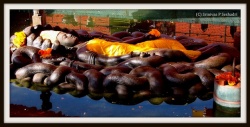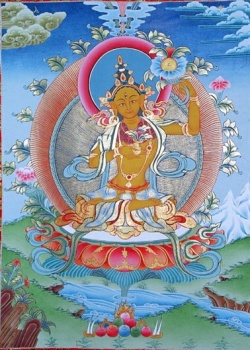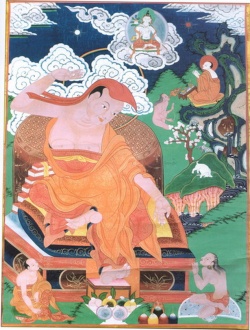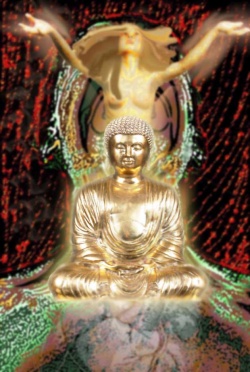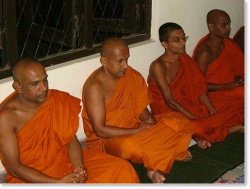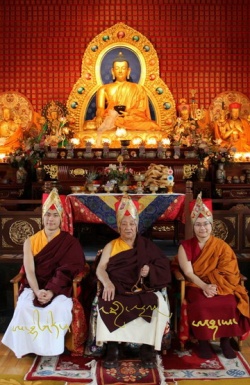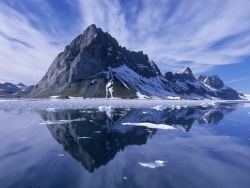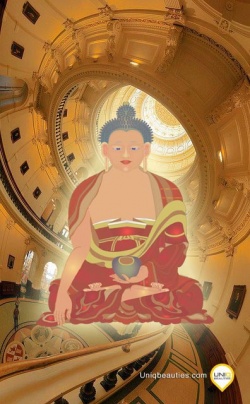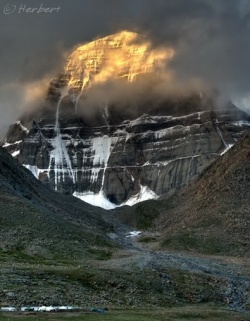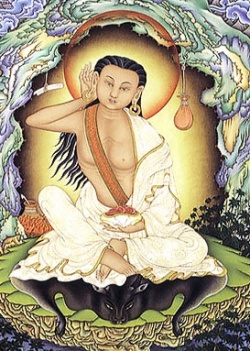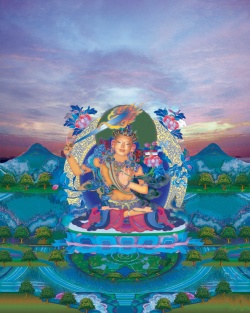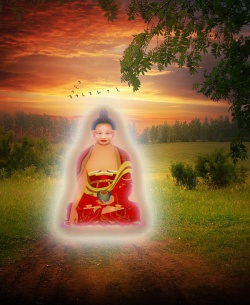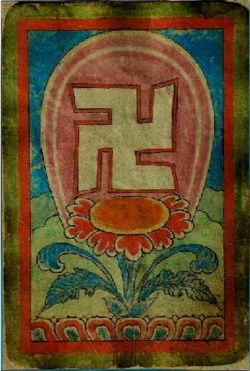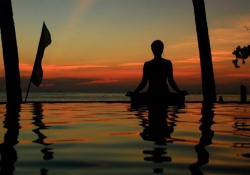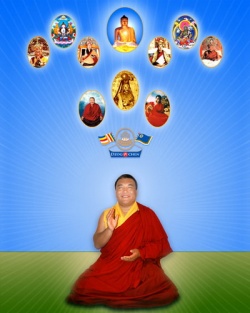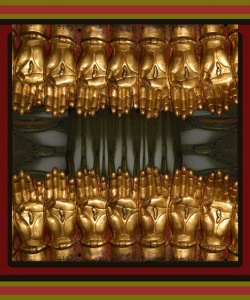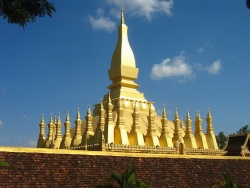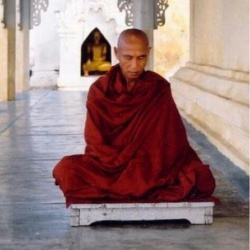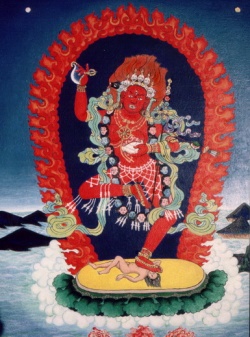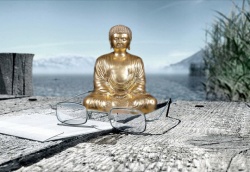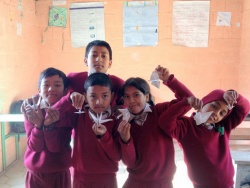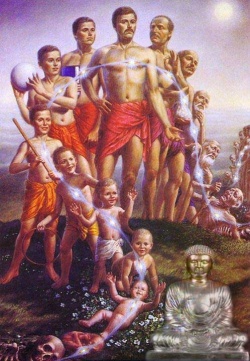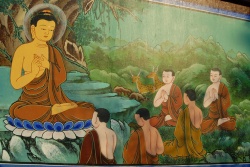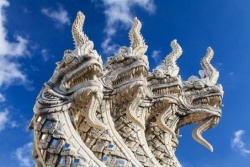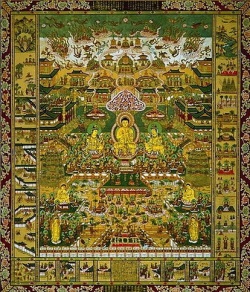Guru Rinpoche, one of the greatest Buddhist yogis of India
Guru Rinpoche, one of the greatest Buddhist yogis of India, is revered as the founder of Tibetan Buddhism.
He is known also as Padmasambhava, his Sanskrit name (Tibetan: Pema Jung-ne), meaning “Born of the Lotus”, and as Guru Oddiyana. In Tibet he is mostly known as Guru Rinpoche, the Precious Master.
Tibetans revere him as the Second Buddha.
The life story of Guru Rinpoche might seem like a wonderful sequence of miracles and supernatural powers, according to stories and legends about his life has been one of the most miraculous stories known to any spiritual tradition of the world.
To understand this we must remember, that our ordinary faculties and habitual patterns of thought are not fully capable to seize the infinite possibilities contained in all that appears and exists.
We can consider Guru Rinpoche as one of those extraordinary beings that from time to time come into our ordinary dimension to turn around our ordinary beliefs and stiff concepts.
Many of these extraordinary beings have appeared on our level of existence for the sole purpose to bring benefit to living beings according to the mentality and culture of the place and time when they appeared and according to the expectations of students.
For Vajrayana Buddhism Guru Rinpoche was undoubtedly one of the greatest benefactors that history has ever known, the “Second Buddha” who manifested himself after the death of the historical Buddha to propagate the esoteric teachings of Tantra and Dzogchen in the course of time.
In the Buddhist tradition in general, it should be noted, that biographies of great realized spiritual masters were not written exclusively to preserve the “historical truth”.
Most of them were composed by spiritual teachers for the exclusive use and consumption of practitioners, with the aim to reinvigorate the sense of respect for the teachings and dedication towards practice.
The stories of liberation and enlightened activities of the great Yogi not always are “history” in the western understanding, but Dharma teachings themselves.
However, whatever doubt you may feel regarding the “historical truth” of the biographies of Guru Rinpoche, one thing is completely sure:
In the second part of 8th century – first part of 9th century has been living an extraordinary Master, who has changed the history of the entire Himalayan region forever.
Guru Rinpoche came alone and on foot to the huge territory inhabited in those days by mostly wild and hostile nations, what we know today as Tibet, Nepal and Bhutan.
He conquered them by sheer power of his charisma and spiritual powers.
Guru Rinpoche is considered representing the enlightened Buddha mind of all Buddhas.
The traditional explanation says Guru Rinpoche has realized the “rainbow body of great transformation”, a body of energy and light in which he remained for a long time to complete all his enlightened activities for the benefit of all sentient beings.
Eight years after the death of the historical Buddha, in the north-west of the Oddiyana land, the “Land of Dakini” – the great and generous King Indrabhuti was returning from his trip together with a large entourage of his ministers and attendants.
On the banks of a lake called Dhanakosha, the king, who has always wanted a heir who could take over his responsibilities, saw a beautiful child approximately eight years old sitting on a lotus flower in the middle of the lake.
This is the story of the miraculous birth of Padmasambhava, the Lotus Born.
For Vajrayana practitioner it’s not hard to see here the deeper meaning behind the metaphorical description. Buddha Nature, present in all beings without exception, is primordially pure, completely untouched by transient faults such as disturbing emotions and the veils created by conceptual thinking and habitual tendencies. These defects do not represent the true essence of living beings but are temporary.
The lotus flower symbolizes the ultimate purity in the eastern cultures.
Although it stems from the mud, the lotus flower is not permanently stained by its dirt, but reaches its ultimate goal – purity and flowering – the same way as Buddhist Tantra and Great Perfection does it.
The child born from the lotus in the middle of the lake probably always has been fully awakened or maybe he has manifested himself there already fully perfect, as if he always had eight years.
Similarly, our Buddha nature is not “born” and will never “cease” according to our ordinary criteria: its manifested presence is completely timeless as soon the layers of wrong self-identification are abandoned.
Guru Padmasambhava comes into the world as fully realized being and spends his life together with dakinis of the primordial wisdom, not like an ordinary being of samsara.
Some biographies mention the names of his parents in flash, but it is completely irrelevant here.
The meaning of his miraculous birth (by a ray of light emitted from the heart of the Buddha Amitabha) lies completely in the timeless nature of the experience of awakening.
The story continues when the astonished king is asking the boy:
“Who are your parents?
What is your lineage?
What is your name?
From which country you’re coming from?
What are you doing here?
How do you spend the time?”
The Lotus Born responded in verse:
My Father is Samantabhadra, the non-dual awareness.
My Mother is Samantabhadri, the ultimate realization.
My lineage is the union of non-dual awareness and absolute realization.
My name is Padmasambhava, the Lotus Born.
My country is the absolute realization, free from arising and cessation.
The food that I eat is dualistic thinking.
I dedicate my time to carry out the activities of a Buddha.
Guru Rinpoche was crowned as a crown prince of the Oddiyana and spent there some years as a king’s advisor. He was taught in the best sciences and arts of the time.
But after several years he realized that to bring the utmost benefit to all sentient beings he should leave the royal apartments.
Guru Rinpoche moved to central India as wandering ascetic.
When he arrived in India he met 5 great masters. Having received the transmissions and instructions from them, he practiced and perfected them in the solitude of forests, jungles, and mountains.
He became known far and wide by many names and everyone knew that he was an extraordinary master who would benefit beings immensely.
At this time, he came to be known as Guru Shakyasimha, ‘Lion of the Shakyas,’ Shakya Seng-ge in Tibetan, and is usually depicted on paintings looking similar to Buddha Shakyamuni.
First of Guru Rinpoche’s earthly teachers was Mahasiddha Prabhahasti.
Secondly, Guru Rinpoche studied with Mahasiddha Prahevajra, known as Lobpon Garab Dorje in Tibet;
he was the first human teacher of Maha-Ati, the ‘Great Perfection’ that is Dzogchen.
Thirdly, Guru Rinpoche received the transmission of the “Guhyagarbha Tantra – The Tantra of the Secret Quintessence” from Master Buddhaguhya.
It is a central Tantra of Vajrayana that Guru Rinpoche later brought to Tibet.
The fourth master who instructed Guru Rinpoche was Mahasiddha Shri Singha who imparted the “Chemchog Heruka Tantra” to him.
Fifth, Mahasiddha Manjushrimitra imparted the empowerment and practice instructions of the “Yamantaka Tantra” to Guru Rinpoche.
Guru Rinpoche practiced all received transmissions and practices in solitary retreats and reached perfection in them.
Furthermore, many other highest Vajrayana transmissions and empowerments were given to him.
It is reported that Guru Rinpoche, known under different names, has been very active in all sorts of Dharma activities and practice in India for 500 years.
Guru Rinpoche actually were fully enlightened even before he left the kingdom of Oddiyana, but searching the path of study and practice he choose to set an example for all living beings regarding the best way to practice Dharma.
Guru Rinpoche travelled to Bodhgaya, the place where historical Buddha Shakyamuni manifested full enlightenment.
He performed several miracles, claiming to be a realized Buddha, but then decided to give an easier example for everyone (including practitioners in future) to follow: he decided to establish a connection with a lineage and a living spiritual master.
For this purpose only he became an ordained Buddhist monk, was practicing and teaching Vinaya (monastic ethical conduct), Sutras and the Abhidharma (philosophical teachings).
Guru Rinpoche showed a complete mastery in the practice of Lesser Vehicle, Hinayana.
Then he went to Rajgir to contemplate on the Sutra of the Perfect Wisdom (Prajnaparamita), the fundamental scriptures of the Mahayana, the Great Vehicle, and accomplished mastery in Mahayana teachings.
Over a long period he practiced tantric sadhana of Vajrakilaya (Tib. Dorje Phurba) in Nepal.
Vajrakilaya is a Yidam that represents the spiritual power and the activity of all Buddhas.
Completeing this practice Guru Rinpoche acquired abilities to remove obstacles and subdue harmful forces that opposes to spiritual progress. In this way he manifested his mastery in all three Vehicles of Buddhist practice.
After some time spent in India Guru Rinpoche decided to go to North-Indian kingdom Zahor.
His arrival was greatly anticipated there. The local king offered great honors to Padmasambhava, a position of a high minister and royal advisor. Guru Rinpoche accepted that, but told he would stay in Zahor only for several years.
The King of Zahor gave him one of his daughters, Princess Mandarava, as consort.
She was also meditating, received many empowerments and realized many perfections in a short time.
Once when princess Mandarava was practicing in a nunnery together with her five consorts and many other nuns, Guru Rinpoche appeared there and was giving instructions in the Maha-yoga, Anu-yoga and Ati-yoga.
The rumour of him being in the monastery with 500 nuns spread in the city and was considered very suspicious. They arrested Guru Rinpoche and Mandarava and decided to burn alive in a huge fire.
But instead of burning, Guru Rinpoche transformed the fire into water and the next day king and his attendants found him sitting in the middle of the lake meditating in bodhisattva posture.
The miraculous lake was named Rewalsar (Tib. Tso Pema) and is a place of pilgrimage till today in Himachal Pradesh in India.
The king repented for his misdoings and, together with many others, became a disciple of Guru Rinpoche.
On this occasion the king of Zahor gave him as offerings the royal robes and hat with what Padmasambhava is most often depicted in iconography and statues.
Guru Rinpoche prophesized that the king will have to go through many rebirths in the lower realms, but at the end his bad karma will exceed and he again will take rebirth in the Land of Snow as the first Buddhist king of Tibet Trisong Detsen and will establish Dharma there.
After leading countless beings to liberation in Zahor, Guru Rinpoche together with princess Mandarava moved to Maratika Cave in Nepal to practise sadhana of Buddha Amitayus – the Buddha of Long Life for three months in retreat.
There they reached the perfection called “Rigdzin” or “control over the life force”.
On this level the yogi is free from the lack of control over their physical health, death and conditions of the next rebirth. The Maratika Cave is still today one of the most revered places of pilgrimage for Vajrayana Buddhism practitioners.
In the monastery of Nalanda, the great Buddhist University in the north of Bodhgaya, five hundred followers of a Hindu sect (Tirthika), who were also dedicated to black magic, challenged Buddhist monks to debates.
The rules of those times dictated that those who would be defeated in the debate would have to convert to the teaching of winners. The Tirthika lost in debate, but defy the Buddhist monks on the ground of magical powers.
When Buddhist monks saw the loss coming, they had a vision of Dakini saying them: “Call for help to my brother! His name is Padmasambhava and his help will come instantly, if the invocation from seven verses is recited sincerely!”
This episode marked the beginning of the famous Prayer to Guru Rinpoche in seven verses, practiced in all lineages of Tibetan Buddhism, but most often in Nyingma tradition.
This prayer is the fastest way to connect with the enlightened energy of Guru Rinpoche. He appeared instantly on the scene of the battle in Nalanda and with the powers of mudra and mantra he hurled the thunder and lightning, magically created by Tirthika, against them crushing them.
The world’s largest Buddhist monastic university was saved now and could continue to study and practice Buddhism.
During that period Guru Rinpoche often manifested himself in forms of Dharma protector and wrathful deities and was known as Guru
Senge Dradok (The roar of the lion). Meditation on Guru Senge Dradok is very useful for subduing irrational energies, black magic, obstacles, envy, bad omens and nightmares.
Before his historic entrance in Tibet Guru Rinpoche took as his consort Princess Shakyadevi, the daughter of the king of Nepal.
Practicing for long time in a cave in Nepal he reached the perfection called “Rigdzin of the great seal”, equivalent to the ninth stage (bhumi) of the great Bodhisattva path.
He met with great master Shri Singha, the lineage holder of the Great Perfection, studied and practiced with him for three years the esoteric disciplines of the Essence of the heart and reached the realization of the “Rainbow Body of the great transformation”.
The great Dzogchen practitioners at the time of death can dissolve their physical body without a trace into the rainbow light, called “Rainbow Body”, if they wish. Or they can transform the physical body into a pure energy and light to use it for the benefit of others.
But others can still perceive it as an ordinary body or not perceive at all. This realization is called “Rainbow Body of the great transformation” and it is the form in which Guru Rinpoche visited Tibet.
In 740 D.C. the king of Tibet Trisong Detsen was born, the twenty-eighth ruler in the dynasty of Chogyal, called King of Dharma.
At that time Tibet was an independent and powerful country, feared by neighboring countries. Trisong Detsen was deeply inspired by Buddhist teachings and sent twelve messengers to India to invite a person who was believed the most learned of all Buddhist teachers at the time – the Nalanda monastery’s abbot – Shantarakshita.
He arrived in Tibet and started to teach the basic principles of the Small Vehicle, explaining the ten virtuous actions and how the principle of cause and effect work (karma).
At that time the first monastery of Tibet was built in Samye Ling.
At that period Tibet was shaken by series of impressive natural disasters: earthquakes, drought, hail, floods and epidemics. In addition to this, also the monastery building works, started at Samye, were going wrong: what was done during the days was somehow mysteriously dismantled during the nights.
Many Tibetans believed it was the result of local spirits rebelling against the foreign religion and were asking the King to expel Shantarakshita from the country.
Trisong Detsen ashamed delivered this message to Shantarakshita and asked what to do. Shantarakshita replied:
“There are big obstacles and powerful forces hostile to the Dharma, and if you are determined to succeed you have to invite Guru Padmasambhava: he is the greatest and most powerful master that exists in the world and might be able to subdue the negative forces that live in this country.
If you will invite him, he will come.”
This way in the year of “Iron Tiger” 810 D.C. , the great Tantric Master and realized siddha yogi Guru Rinpoche arrived on foot to Tibet to fulfill the mission to introduce Buddhist teachings in Tibet, where Shantarakshita, follower of the Sutra-yana had failed.
Guru Rinpoche was traveling alone on foot but Trisong Detsen was eagerly expecting him, he went to meet him together with his ministers, nobles and 500 men on horses.
He expected the new Guru will be much like abbot Shantarakshita, he gave him his honour, praise and prostrated before Guru Rinpoche. Guru Rinpoche replied with several verses beginning with:
O great King of Tibet, listen to me now:
In all six realms of existence humans are subject of death.
But I am the one who has attained the state beyond birth and death
Who have the secret instructions for the timeless realization.
For me the whole universe is nothing else but the manifestation of mind.
Obstacles and harmful spirits are my hobby and my faithful assistants.
Everything that appears and exists belongs to me:
I’m the king of the universe and the one controlling all phenomena.
I am the great Guru Padmasambhava, the King Padmasambhava….
Guru Rinpoche travelled throughout Tibet manifesting his miraculous activities and subjugating negative interferences and obstacles, created by humans and non-humans.
Dancing on the top of the mountain overlooking Samye he tamed all powerful spirits of Tibet and took them under his command, loudly singing the verses known as “Subdue arrogant beings”.
All hostile and irrational forces of Tibet promised to stop creating obstacles to Dharma but instead to protect the practitioners in all times.
The Samye Monastery was completed in five years and consecrated by Guru Rinpoche and Shantarakshita – who did return in the meantime. Samye became a place of studies and preservation of Dharma treasures, as well as the home of the teachings of the greatest masters of the time.
Under the supervision of Guru Rinpoche, Vimalamitra, Shantarakshita and Kamalashila 108 young Tibetans were trained as translators from Sanskrit to Tibetan.
They translated most part of the teachings that today form the Tibetan Buddhist Canon:
The texts of the Sutra and Tantra of all nine vehicles of the Dharma. Shantarakshita gave an order for the very first seven Tibetan monks in the history to test their abilities to lead a monastic life. The trial was successful and many others followed them.
Guru Rinpoche transmitted to the King and many Tibetans many tantric initiations and instructions.
Many of his students attained full enlightenment in this very lifetime. During this period two types of Sangha (spiritual community) were founded: those who are dressing in red, lives in celibacy in monasteries and that of Ngakpa order (tantric mantrayana practitioners), who are dressed in white, have long hair and are living with their families in the villages. With the introduction of this second type of Sangha, Dharma flourished not only in monasteries, but also among people everywhere.
Guru Rinpoche transmitted an incalculable number of spiritual instructions that were written down by his Tibetan consort dakini Yeshe Tsogyal, the embodiment of enlightenment and inner wisdom.
To prevent the loss of these precious teachings and the progressive deterioration of their strength, they were hidden for the benefit of practitioners in the future – so they can re-emerge in the most appropriate place and time, depending on the degree of maturity and mental inclinations of individuals.
These hidden teachings are called Terma (hidden Dharma treasures).
These teachings have been transmitted in the lineage of succession of teachers through the ages and periodically new hidden teachings have been found or revealed to some great spiritual masters.
In the year 864 (55 years after his arriving in Tibet) Guru Rinpoche announced to his followers that his mission in Tibet is coming to an end, he is going to another dimension.
Accompanied by his consort Yeshe Tsogyal he went up in the mountains where he meditated for a while in a cave and gave the final instructions to his wife Yeshe Tsogyal to be delivered to the Buddhism practitioners in the future:
Padmasambhava is now going to the Land of great bliss.
I am moving to the Dharmakaya, the condition free from birth and death:
There are no separation between body and mind that happens to the ordinary beings.
Meditate on Guru Yoga, the quintessence of all methods.
Above your head on a seat of lotus and moon, surrounded by rainbow light, Padmasambhava appears.
When the manifestation is clear, receive the blessings and meditate on their meaning.
Recite the mantra “Benza Guru..” the essence of all mantras and invocations.
It will merge your body, speech and mind inseparably with my parents.
Dedicate the merits and wishes to the benefit of all beings.
Contemplate effortlessly to the essence of Great Perfection.
There are no teachings above this.
The compassion of Padmasambhava knows no ups and downs, it remains forever.
For those who address their prayers to Guru Rinpoche, he will always be in front of them.
For those who have faith there is no separation from Guru!
Guru Rinpoche had a huge following of disciples in Tibet.
Three of his students are always portrayed beneath him in the paintings of refuge tree: the Dakini Yeshe Tsogyal, the King Trisong Detsen and the “student” Vairochana.
Yeshe Tsogyal was his consort and disciple who traveled with him all over Tibet, received all his teachings and practiced them and achieved the ultimate perfection.
She continued to reveal the hidden spiritual treasures of Tibet even after the departure of Guru Rinpoche.
Trisong Detsen was very close disciple and helped much to introduce Tibet with Buddhism, thanks to his determination to invite to Tibet the greatest Buddhist teachers of the time as Guru Rinpoche and Shantarakshita.
Vairochana was the best translator. He often traveled to India, where he received initiations and texts of Tantra and Dzogchen directly from the great masters like Shri Singha and others.
Vairochana was one of the first seven Tibetans who received monastic ordination. At the time of his death he realized the rainbow body. And so did his root disciples in the next seven generations.
Except the King Trisong Detsen, Guru Rinpoche had twenty-five main disciples in Tibet.
They all attained the highest realization including the rainbow body and each became famous in Tibet for some special aspect of their practice or activity. Also a large number of other disciples reached the rainbow body.
Among his entourage of disciples, Guru Rinpoche had numerous women who gained extraordinary spiritual realizations.
